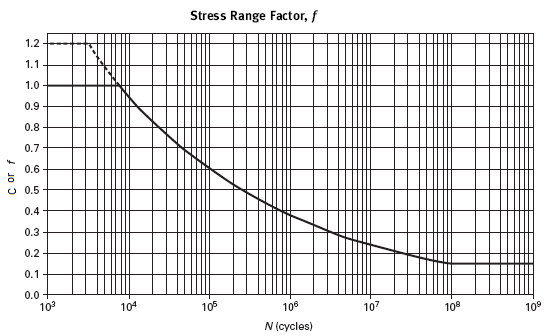Related Resources: pressure-vessel
Weld Joint Reduction Factor for Pressure Vessel and Piping
ASME Pressure Vessel Design and Engineering
Pressure Vessel and Piping Weld Joint Reduction Factor - Weld Joint Corrosion Reduction Factor
Weld Joint Strength Reduction Factor,W or weld joint corrosion reduction factor, C. At elevated temperatures, the long-term strength of weld joints can be lower than the long-term strength of the base material. For longitudinal or spiral welded pipe (i.e., not seamless), the product of the allowable stress and the applicable weld quality factor, SE, shall be multiplied by the weld joint strength reduction factor, W, when determining the required wall thickness for internal pressure per ASME b31.3 para. 304. The designer is responsible for the application of weld joint strength reduction factors to welds other than longitudinal and spiral (e.g., circumferential). The weld joint strength reduction factor, W, is equal to 1.0 when evaluating occasional loads such as wind and earthquake, or when evaluating permissible variations in accordance with para. 302.2.4. The pressure rating or allowable stress for the occasional load or variation condition is not required to be reduced by the weld joint strength reduction factor. It is also not required when calculating the allowable stress range for displacement stresses, SA, in para. 302.3.5(d) or the allowable operating stress limit, So A, in para. P302.3.5(d). The weld joint strength reduction factor only applies at weld locations. The weld joint strength reduction factor is the ratio of the nominal stress to cause failure of the weld joint to that of the base material for the same duration.

ASME Pressure Vessel and Piping Weld Joint Strength Reduction Factor, W
The weld joint strength reduction factor only applies at weld locations. The weld joint strength reduction factor is the ratio of the nominal stress to cause failure of the weld joint to that of the base material for the same duration.
Steel Group |
ComponentTemperature, °C (°F) |
||||||||||||||
427 (800) |
454 (850) |
482 (950) |
510 (950) |
538 (1,000) |
566 (1,050) |
593 (1,100) |
621 (1,150) |
649 (1,200) |
677 (1,250) |
704 (1,300) |
732 (1,350) |
760 (1,400) |
788 (1,450) |
816 (1,500) |
|
CrMo |
1 |
0.95 |
0.91 |
0.86 |
0.82 |
0.77 |
0.73 |
0.68 |
0.64 |
- |
- |
- |
- |
- |
- |
CSEF (N+T) |
- |
- |
- |
1 |
0.95 |
0.91 |
0.86 |
0.82 |
0.77 |
- |
- |
- |
- |
- |
- |
CSEF |
- |
- |
1 |
0.5 |
0.5 |
0.5 |
0.5 |
0.5 |
0.5 |
- |
- |
- |
- |
- |
- |
Autogenouswelds |
- |
- |
- |
1 |
1 |
1 |
1 |
1 |
1 |
1 |
1 |
1 |
1 |
1 |
1 |
Austenitic stainless grade 3xx and N088xx nickel alloys |
- |
- |
- |
1 |
0.95 |
0.91 |
0.86 |
0.82 |
0.77 |
0.73 |
0.68 |
0.64 |
0.59 |
0.55 |
0.5 |
Other materials |
- |
- |
- |
- |
- |
- |
- |
- |
- |
- |
- |
- |
- |
- |
- |